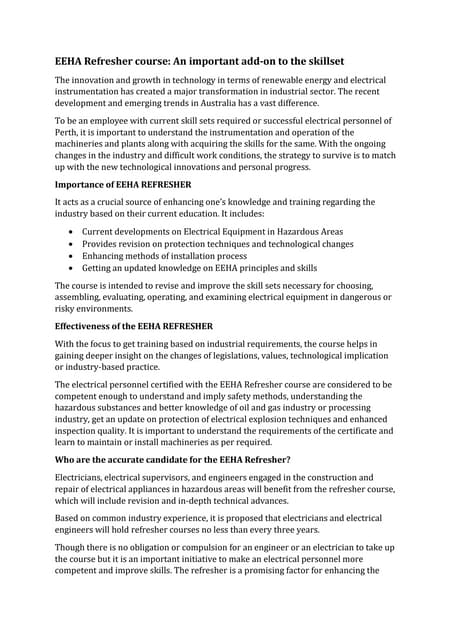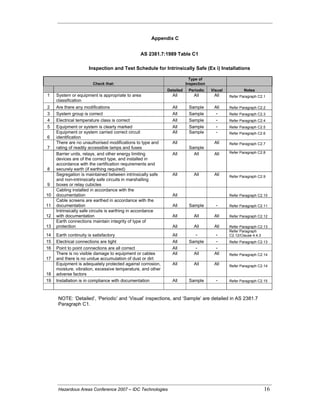The Facts About Roar Solutions Uncovered
Wiki Article
Roar Solutions for Beginners
Table of Contents7 Simple Techniques For Roar SolutionsRoar Solutions - QuestionsThe smart Trick of Roar Solutions That Nobody is Discussing
In such an atmosphere a fire or surge is possible when three basic problems are satisfied. This is frequently described as the "unsafe location" or "burning" triangular. In order to protect installments from a potential surge an approach of evaluating and identifying a potentially harmful area is required. The function of this is to ensure the correct selection and installment of tools to inevitably protect against a surge and to make sure security of life.
(https://sandbox.zenodo.org/records/174151)
No devices needs to be mounted where the surface area temperature of the tools is greater than the ignition temperature of the provided danger. Below are some usual dirt hazardous and their minimum ignition temperature. Coal Dust 380C 225C Polythene 420C (thaws) Methyl Cellulose 420C 320C Starch 460C 435C Flour 490C 340C Sugar 490C 460C Grain Dirt 510C 300C Phenolic Material 530C > 450C Aluminium 590C > 450C PVC 700C > 450C Soot 810C 570C The probability of the threat existing in a concentration high sufficient to trigger an ignition will vary from location to location.
Hazardous area electric devices possibly made for use in greater ambient temperatures. Field Repair Service By Authorised Personnel: Challenging screening might not be needed nevertheless details treatments may require to be adhered to in order for the tools to preserve its third celebration rating. Each piece of equipment with a harmful rating must be reviewed individually.
Roar Solutions for Beginners
The tools register is a comprehensive data source of equipment documents that includes a minimum collection of areas to identify each product's area, technical parameters, Ex-spouse classification, age, and ecological data. This details is vital for tracking and taking care of the devices effectively within hazardous locations. In contrast, for routine or RBI tasting inspections, the quality will be a combination of Detailed and Close inspections. The ratio of Detailed to Shut inspections will be identified by the Tools Risk, which is evaluated based upon ignition risk (the likelihood of a resource of ignition versus the probability of a combustible ambience )and the unsafe area category( Area 0, 1, or 2). This variant will certainly also affect the resourcing needs for job prep work. When Great deals are defined, you can establish tasting plans based on the sample size of each Great deal, which describes the variety of arbitrary equipment products to be evaluated. To identify the called for example dimension, two aspects need to be assessed: the dimension of the Great deal and the group of assessment, which shows the degree of effort that need to be applied( minimized, regular, or enhanced )to the examination of the Lot. By combining the classification of assessment with the Great deal size, you can then establish the proper being rejected criteria for an example, indicating the permitted number of damaged items found within that sample. For more information on this process, please refer to the Power Institute Guidelines. The IEC 60079 conventional advises that the maximum interval between assessments ought to not surpass 3 years. EEHA inspections will certainly likewise be conducted beyond RBI projects as part of set up upkeep and devices overhauls or repair services. These evaluations can be attributed toward the RBI sample dimensions within the influenced Great deals. EEHA assessments are conducted to identify mistakes in electrical equipment. A heavy racking up system is vital, as a single item of devices might have several Going Here faults, each with differing levels of ignition risk. If the mixed score of both assessments is much less than twice the mistake rating, the Whole lot is considered acceptable. If the Whole lot is still taken into consideration undesirable, it has to go through a complete evaluation or justification, which might trigger stricter evaluation protocols. Accepted Great deal: The root causes of any kind of faults are recognized. If a common failing mode is located, additional devices might need maintenance. Faults are identified by seriousness( Safety, Stability, House cleaning ), guaranteeing that immediate issues are assessed and resolved quickly to alleviate any effect on safety and security or operations. The EEHA data source must track and tape the lifecycle of mistakes together with the rehabilitative actions taken. Executing a durable Risk-Based Inspection( RBI )technique is crucial for making sure conformity and safety in managing Electric Devices in Hazardous Areas( EEHA) (high voltage courses). Automated Fault Rating and Lifecycle Monitoring: Easily manage faults and track their lifecycle to enhance inspection precision. The introduction of this assistance for risk-based assessment further reinforces Inspectivity's placement as a best-in-class remedy for regulatory conformity, as well as for any asset-centric evaluation use case. If you want finding out more, we welcome you to ask for a demo and find exactly how our service can transform your EEHA management processes.
Get This Report on Roar Solutions

In terms of explosive threat, an unsafe area is an environment in which an explosive ambience is present (or might be anticipated to be present) in amounts that need special precautions for the construction, installment and use devices. hazardous area course. In this post we check out the obstacles encountered in the work environment, the risk control procedures, and the required proficiencies to work safely
It is an effect of contemporary life that we make, store or manage a variety of gases or fluids that are deemed combustible, and a variety of dirts that are deemed combustible. These compounds can, in particular conditions, create eruptive ambiences and these can have major and tragic repercussions. The majority of us recognize with the fire triangular get rid of any type of among the 3 elements and the fire can not take place, yet what does this mean in the context of dangerous areas? When damaging this down right into its simplest terms it is essentially: a mix of a particular amount of release or leakage of a certain substance or material, mixing with ambient oxygen, and the visibility of a source of ignition.
In most instances, we can do little about the degrees of oxygen airborne, however we can have considerable impact on resources of ignition, as an example electrical equipment. Hazardous areas are documented on the dangerous area classification drawing and are determined on-site by the triangular "EX LOVER" indicator. Below, among various other vital information, zones are split right into three types depending on the risk, the likelihood and period that an explosive atmosphere will exist; Area 0 or 20 is regarded one of the most dangerous and Area 2 or 22 is considered the least.
Report this wiki page